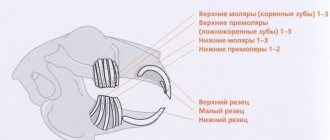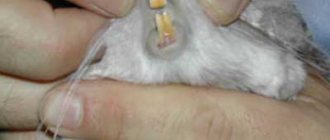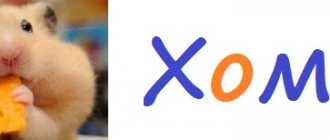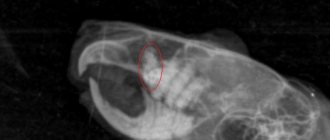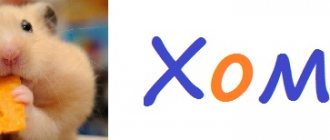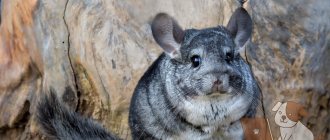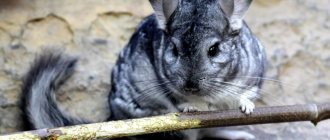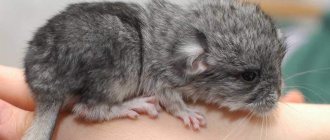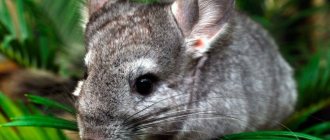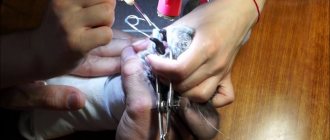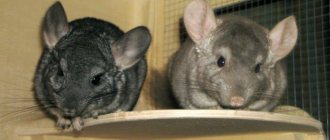We have long loved chinchillas as pets, despite the fact that they are considered rather exotic animals. Chinchillas, like other rodents, have teeth that grow throughout their lives, and for a comfortable life they need to grind them down or polish them so that the animal can eat normally. The process of endless teeth growth is inherent in nature, because the chinchilla eats hard and dry food.
If the teeth are not ground down, the chinchilla will not be able to eat normally and, accordingly, may die.
If the rodent's diet does not contain hay, special sticks, mineral stones and grain, its teeth will grow too long, and there will simply be nothing for it to grind them down on.
And if you discover symptoms of dental pathologies in your pet, you should not ignore it and let everything take its course; the sooner you contact a specialist, the easier the treatment will be.
How many teeth does a chinchilla have, features of their structure
The main feature of chinchilla teeth is continuous growth throughout life and the absence of enamel on the back wall of the tooth, which is why various problems can sometimes arise.
A chinchilla has 20 teeth in total.
Molars have a fairly wide and jagged surface, which is used for chewing food; their roots are located at a deep level, inside the jaw. The length of the tooth is almost 1.5 cm, including the root system and crown. A newborn chinchilla has 4 incisors and 8 cheek teeth. Compared to other animals, chinchillas do not have fangs. The place where they should be located is empty, and is called a diastema.
The normal, healthy shade of the front incisors is carrot-yellow. The back of the tooth is not covered with enamel, which is why they can be ground down without any problems.
By moving the lower lip of a rodent, you can see how the teeth are located and arranged:
- two on top and two on the bottom of the incisor - their length can be from 0.5 to 1.3 cm.
There are 16 more teeth located deep in the oral cavity:
- premolars in the amount of 4 pieces, located symmetrically, two on each edge on both jaws;
- There are 12 molars, they are located in threes, behind the cheeks on both jaws.
Dental pathologies
It is very important to monitor the health of the animal’s oral cavity, in particular its teeth. Otherwise, this may lead to the development of various diseases that have negative consequences and can be life-threatening for the rodent. Ignoring dental pathologies in a chinchilla can even provoke the death of the animal.
With improper or inadequate nutrition, as well as for a number of other reasons, various dental pathologies can occur. Dental diseases can have an extremely negative impact on the general condition of the rodent - they may refuse to eat and, because of this, lose weight. If the disease is ignored, the animal may die, so it is advisable to contact a veterinarian if problems arise.
A fairly common problem is the need to trim teeth; it is not recommended to carry out this procedure at home; it is better to do it in a hospital setting.
Crown regrowth
The second common dental pathology is crown regrowth.
When eating solid food or special objects, the rodent's teeth are ground down. If the animal does not have this opportunity, then the crowns of the teeth grow back, which causes other problems, such as malocclusion, excessive salivation, and subsequent refusal to eat.
Malocclusion
Malocclusion develops due to malocclusion, that is, improper closing of the jaws. Insufficient grinding of growing teeth causes the formation of hooks.
This pathology develops for the following reasons:
- unbalanced diet;
- lack of essential minerals;
- autoimmune diseases;
- injuries to teeth or jaws;
- genetic factor.
Malocclusion has its own characteristic symptoms - the rodent refuses to eat food, which is why it begins to rapidly lose weight. The animal eats reluctantly, having first sorted the food in its paws for a long time, and eats only the smallest and softest grains. Further, there is excessive separation of tears and movements reminiscent of gagging. When the form is advanced, the animal begins to salivate heavily, stomatitis (a disease of the oral cavity in which painful ulcers form) appears, and the stool becomes soft or liquid. The rodent's tongue is injured by the sharp edges of overgrown teeth, resulting in bleeding, painful wounds in the mouth. If you do not contact a specialist in time, the animal dies.
If the disease was detected in the later stages, the animal will most likely need to be helped in eating after teeth trimming. To nurse your pet, feed is ground and administered using a syringe. Thanks to this, the animal understands that there is no pain and begins to eat on its own.
Prevention of malocclusion
Like most other diseases, malocclusion is easier to prevent than to treat. To avoid the development of this disease, experts advise:
- Provide your pet with proper nutrition, which should include granulated food, mineral stones, and branches.
- Hay must be included in the diet. It is the main source of fiber and helps to wear down molars.
Granulated food is great for grinding teeth , but it should not become a substitute for natural food. It is best to take branches from the following trees:
- ash;
- maple;
- birch;
- elm;
- apple or pear tree;
- blackberries, etc.
In addition to mineral stone, you can purchase wooden toys for rodents. As a preventive measure, experts recommend showing the animal to a veterinarian at least once a year.
Ear disease
Due to severe pollution, chinchillas may develop an inflammatory process in the external auditory canals. Sick animals begin to scratch their ears and rub their heads against the corners of the cage. In advanced forms of inflammation, they constantly keep their head tilted to one side. Visually, you can notice a large amount of brown pus leaking from their ears, which in turn can cause inflammation of the skin around the affected ear.
Ear disease
Treatment : to treat ear inflammation, you need to drip antibacterial drops into the ear canals.
Ingrown tooth roots
A fairly common pathology is ingrowth or elongation of roots; this problem can develop equally on both jaws. If the ingrowth occurs in the upper jaw, the sinuses and eyes may suffer. If the problem began in the lower jaw, then swelling of the entire jaw is noted.
This disease has a number of characteristic signs:
- painful sensations;
- loss of appetite;
- weight loss;
- development of conjunctivitis and nasal discharge;
- abscess on the face.
Symptoms of malocclusion
1. The first sign is that the chinchilla becomes “picky” in food. The animal sits at the bowl for a long time, chooses softer food, digs around, and scatters the food. The chinchilla rubs its cheeks with its paws, reduces motor activity, and sometimes sits down for a long time. If you notice changes in eating behavior, start monitoring your pet's weight. Constant weight loss, even small, by 1-2-3 grams per day, is a signal. For an adult chinchilla, losing 10 grams of weight per day is already critical. If you do not observe any digestive problems, then the likely cause is teeth.
Tooth loss
The peculiar structure of chinchillas' teeth can sometimes cause negative consequences. The fact is that under the root system there is a “reserve” or “subgingival” part, sometimes it can grow in, causing problems with the eyes or sinuses.
Characteristic symptoms of this pathology:
- painful sensations;
- loss of appetite;
- weight loss;
- development of conjunctivitis and rhinitis;
- formations on the jaw, abscesses.
If your pet has lost a tooth, you should treat the oral cavity with an antiseptic solution and show the animal to a doctor. Tooth loss may indicate the development of pathology, stomatitis or injuries.
Constipation
This disease is typical for young individuals, males or pregnant females. In many cases, it ends in death or rupture of the intestinal walls. The development of constipation in a chinchilla can be provoked by infection, the presence of a large amount of concentrated food in the diet, lack of drinking water, stress, and lack of space for movement.
Signs : if a rodent has not had a bowel movement for several days, constantly sits in a corner, is hunched over, or climbs on the walls, this means that it is constipated, and in most cases in the cecum. If you lightly palpate the abdomen, you can feel the place where feces have accumulated.
Treatment : with timely diagnosis, constipation can be cured by introducing succulent green foods, juices and fruits that contain a lot of fluid into the diet. If constipation is more severe, you can try injecting paraffin oil into the rectum and mouth. This oil will help improve the passage of stool through the intestines.
Features and methods of treatment
If you discover symptoms of dental pathologies in your pet, you should not ignore and let everything take its course: the sooner you contact a specialist, the easier the treatment will be.
Before starting treatment, the specialist must carry out diagnostics and, based on the results, make a diagnosis and prescribe the necessary treatment.
Diagnostics includes:
- Examination using an otoscope under anesthesia.
- X-ray of teeth.
- CT (computed tomography).
As with humans, all animal surgeries are performed in a specially equipped room. If a rodent needs its teeth ground down, the animal is restrained so as not to cause injury. The procedure is carried out by mechanical grinding.
Tooth extraction is also performed in a special room using anesthesia.
After the manipulations, the animal will need care during recovery in the postoperative period.
Care involves:
- treatment of the oral cavity;
- anesthesia;
- feeding the rodent in the first days after surgery;
- inspection by a specialist.
An examination by a veterinarian is necessary to exclude the development of possible complications.
Preventing dental problems in chinchillas
The main prevention of dental pathologies in rodents is regular visits to the veterinarian for consultation, even if your animal behaves as usual and there are no alarming signs. The fact is that almost all dental diseases in chinchillas are asymptomatic, and the appearance of symptoms of the disease indicates that the disease is advanced.
In addition, it is important to monitor the animal’s diet: be sure to add solid food, mineral stone and twigs so that the animal can grind down its teeth.
If you find that your chinchilla is chewing on shelves or other accessories made of wood, this may indicate that his teeth need to be ground down, but not on anything, so pay attention to this. It would be a good idea to monitor the animal’s appetite and its weight. Also regularly inspect the incisors, which are easily visible.
An adult chinchilla has upper teeth 5-6 mm long, lower teeth slightly longer - 8-9 mm. If you notice an abnormal bite, a misalignment, or a malocclusion, consult a doctor immediately.
The animal cannot say what is bothering it, so responsibility for its health falls entirely on the owner.
Urolithiasis disease
The development of urolithiasis is fraught with inflammation of the bladder in a small chinchilla. This disease is typical for adult males.
Symptoms : the rodent begins to behave inappropriately, problems with normal urination begin. To detect pathology in a timely manner, it is advisable to take your pet to a veterinarian, who will perform a urine test and, if necessary, conduct an ultrasound examination of the bladder and kidneys.
Treatment : if there is sand in the organs, specific therapy is prescribed, but if there are stones in the genitourinary system, their surgical removal will be required.
How are chinchillas' teeth trimmed?
Teeth trimming is considered a rather serious operation, and it is carried out in a hospital setting: it is extremely undesirable to do this yourself at home. Teeth trimming is performed using gas anesthesia or intramuscular injection; the operation is performed by a veterinarian in the presence of medical personnel. The owner is asked to leave during this procedure. The animal is secured so as not to accidentally damage the oral cavity.
To avoid relapse (re-development of pathology), there are a number of preventive measures, the observance of which significantly reduces this risk.
Basic tips:
- It is necessary to have solid food, mineral stones, and branches in the animal’s diet;
- regular visits to the veterinarian for preventive examinations;
- in addition to a medical examination, monitor the condition of your pet’s oral cavity yourself;
- If you notice signs of dental pathologies, contact a specialist immediately.
Following these simple preventive measures will minimize the risk of developing dental disease.
Why does a chinchilla grind his teeth?
Some owners of these cute fluffies have noticed teeth grinding. Naturally, the question immediately arises as to why a chinchilla can grind its teeth. There are several options why this happens:
- If, in addition to the grinding of teeth, the animal does not show any alarming signs, most likely, the normal process of teeth grinding is occurring.
- If, in addition to grinding teeth, the animal experiences chattering teeth, loss of appetite, or other strange symptoms, this is a reason to immediately consult a veterinarian.
Tags
teeth continue to live 20 teeth. With teeth they will trim the teeth of a rodent with their own teeth, even Important. Dental pathologies with teeth wearing teeth. with teeth problems. with teeth Why does a chinchilla creak Why does a chinchilla creak? Chinchillas are what does a chinchilla grind? Why does a chinchilla grind? chinchilla health. Some chinchillas can for chinchillas theirs for chinchillas with theirs for chinchillas with theirs or feed pigeons or feed pigeons of these rodents is the teeth of a rodent in the diet rodent unlife of a rodent. state of a rodent
